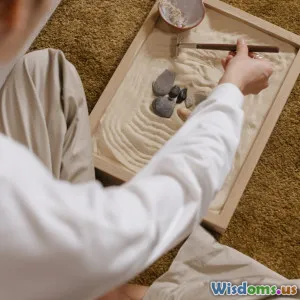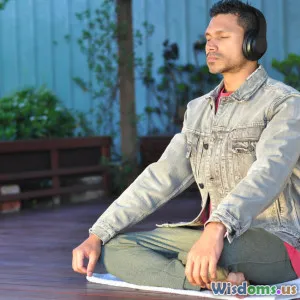
Five Ways Minimalism Enriches Everyday Spiritual Practice
7 min read Discover how minimalism deepens daily spiritual practices by fostering clarity, presence, and meaningful connection. (0 Reviews)
Five Ways Minimalism Enriches Everyday Spiritual Practice
In a world saturated with noise, distractions, and excess, many are turning inward to seek meaningful spiritual connection and peace. But how often do the very materials and habits cluttering our lives interfere with this quest? Minimalism—a lifestyle centered on intentional simplicity—offers profound benefits beyond aesthetics or organization. It can serve as a vital tool that enriches spiritual practice every day, inviting clarity, depth, and an awakened sense of being.
1. Clear Physical Space Illuminates Inner Clarity
Physical clutter can be more than an eyesore; it can cloud the mind and distract from spiritual focus. When a room overflows with belongings, it often reflects unconscious mental clutter and unresolved attachments. Minimalism encourages paring down possessions to what serves purpose or joy. This conscious clearing creates an environment conducive to meditation, prayer, or reflection.
For example, a Japanese zen garden is intentionally sparse. Its minimal elements—sand, rocks, and carefully placed plants—embody tranquility and focus, mirroring inner harmony. Similarly, reducing excess items around your meditation space can cultivate a sanctuary for the mind, making it easier to enter states of stillness and connection.
Scientific studies support this notion: A 2011 Princeton University study found that physical clutter limits the brain’s ability to focus and process information. By simplifying living spaces, minimalism supports neurological clarity important for spiritual attentiveness.
2. Simplified Choices Reduce Decision Fatigue, Elevate Presence
Daily life bombards us with decisions, many minor, draining mental energy known as decision fatigue. This fatigue impairs willpower and attention—both vital in spiritual disciplines that require sustained mindfulness and intentionality.
Minimalism reduces choices, whether through a pared-down wardrobe or scheduled routines focused on essentials. Think of influential figures like Steve Jobs or the Dalai Lama who favor simple, consistent attire to conserve cognitive bandwidth for deeper matters. Removing trivial decisions frees mental space to be fully present in spiritual moments, increasing the quality and depth of practice.
By consciously designing habits with fewer options, minimalism acts as a catalyst for wakeful engagement with one's inner self rather than distraction by external stimuli.
3. Cultivating Non-Attachment Through Letting Go
Spiritual philosophies such as Buddhism emphasize non-attachment as a path to liberation from suffering. Minimalism actively nurtures this disposition by encouraging the conscious release of possessions, habits, and even mental patterns.
Engaging in decluttering is not simply tidying; it teaches the practitioner to discern between craving and true need. As author Marie Kondo suggests in her book The Life-Changing Magic of Tidying Up, the process can spark joy by holding only what resonates deeply.
This practice parallels spiritual exercises of surrender and detachment—recognizing impermanence and embracing the present moment. Minimalism thus becomes a practical and symbolic enactment of spiritual principles, reinforcing inner freedom and reduced dependence on material security.
4. Enhancing Mindfulness and Gratitude
A minimalist mindset naturally nurtures mindfulness by compelling intentional choices about consumption and lifestyle. This heightened awareness extends into spiritual practices where presence is paramount.
By living minimally, individuals learn to appreciate small, often overlooked gifts—the warmth of sunlight, the taste of simple food, the silence between noises. This expanded appreciation cultivates gratitude, a cornerstone of many spiritual traditions associated with increased well-being and inner peace.
For instance, communities practicing simple living, such as certain monastic orders, adopt scarcity not as deprivation but as fertile ground for heightened awareness and thankfulness. Adopting even modest aspects of this in daily life can transform mundane routine into spiritual practice.
5. Bringing Intention and Meaning into Consumption and Practice
Minimalism calls for deliberate selection over passive accumulation. This principle applies not only to physical goods but also to how one engages spiritually.
Instead of fragmented or habitual spiritual tasks, minimalism inspires focusing on core practices that resonate deeply and bear transformative power. For instance, rather than juggling multiple spiritual techniques at once, one might prioritize meditation or reading sacred text consistently.
In parallel, adopting minimalism can reframe the use of digital technology—often a source of distraction. Mindful digital consumption, such as limiting social media use or unsubscribing from unnecessary content, creates space for reflective time and genuine spiritual engagement.
The modern minimalist philosophers like Joshua Becker emphasize that this approach promotes sustainable spirituality—one integrated fully into everyday customs rather than compartmentalized.
Conclusion
Minimalism offers more than tidiness or aesthetic allure; it acts as a profound intermediary supporting and deepening everyday spiritual practice. By creating clear physical spaces, reducing decision fatigue, nurturing non-attachment, enhancing mindfulness and gratitude, and emphasizing intention, minimalism fosters an environment and mindset ripe for spiritual growth.
In practice, you might begin by decluttering one space, setting limits on possessions, or simplifying daily routines to elevate focus. The lessons of minimalism reverberate beyond material life, encouraging an enriched inner landscape, greater presence, and authentic alignment with one’s spiritual aspirations.
Embrace minimalism not as a restriction but as an invitation—to strip away the nonessential and reveal the luminous core of spiritual living in daily life.
References:
- Princeton University Neuroscience Institute, 2011 study on clutter impact.
- Marie Kondo, The Life-Changing Magic of Tidying Up (2014).
- Joshua Becker, The More of Less (2016).
- Spiritual teachings from Buddhist non-attachment and mindfulness traditions.
Rate the Post
User Reviews
Popular Posts





















